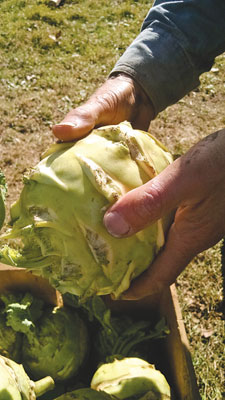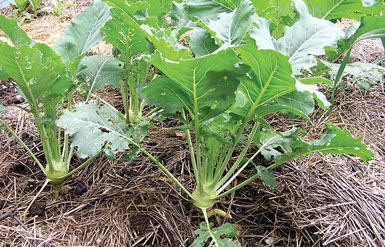 |
| Will Bonsall holds a ‘Gigante’ storage kohlrabi. Photo by Yaicha Cowell-Sarofeen |
 |
| Summer kohlrabi varieties are much smaller than the storage types and should be eaten within a few days of harvest. English photo |
By Will Bonsall
The so-called “cabbage family” – actually the species Brassica oleracea – has given us several botanical monstrosities we enjoy as food, but none I think is quite so outré as the kohlrabi. In fact most of this wacky family – cabbage, Brussels sprouts, cauliflower, broccoli, collards, kale, etc. – bear little resemblance to their common ancestor, colewort, a nondescript weed found near the cliffs and beaches of the Baltic and North Seas. Kale probably comes closest, with its loose tuft of foliage; and the large, tight, leafy “heads” of cabbage and the tiny “heads” of Brussels sprouts, the undeveloped flower heads of cauliflower and broccoli, are all kinky mutations, but kohlrabi has got them all beat for downright eccentricity.
By the way, notice that the root word “kol” turns up in most of the names of these variants, and in the case of kohlrabi the added part “rabi” is cognate with the root word “rapa,” from the Latin for turnip (as in rape, rapini, etc.). For example the French word for kohlrabi – “chou-rave” – means “cabbage-turnip,” although it is only distantly related to the turnip (Brassica rapa).
Visitors who see kohlrabis in our garden often comment on their “otherworldly” appearance, like tennis balls with leaves sprouting from their sides. (Yes, I know tennis balls don’t have “sides,” but I mean as opposed to the bottoms.) In fact “soccer balls” might be a more apt comparison for the storage types, which can easily exceed 10 pounds (the record is 62), and despite their UFO-ness, in my opinion they are perhaps the most down-to-earth member of the zany clan. I mean “down-to-earth” partly because they are actually a swollen stem, forming just inches above the soil, but also because they are so eminently practical to grow, store and eat. In terms of comfort-giving, hardy winter sustenance, they are second only to the rutabaga in my estimation, and for raw use I rate them first due to their milder, less turnipy flavor. However, I am referring to the storage kohlrabi here, which is really getting ahead of myself, so let’s back up a bit.
The best-known kohlrabi is the summer type, such as ‘White’ or ‘Purple Vienna’. (By the way, the color is irrelevant, since the pigment is in the outer rind only, which peels off.) They do not stand particularly well in the field; as the “bulbs” start to elongate, the lower half becomes fibrous and the upper half goes pithy and they start to crack. Therefore they should be harvested when only 3 to 3-1/2 inches in diameter. Once picked they should be used within a few days for maximum crispness. With storage types such as ‘Gigante’ and ‘Superschmelz’, this is not an issue.
I grow the two types differently. I start the summer types indoors as early as I start my broccoli; in fact I plant the two together in the garden, as I’ll explain. All brassicas suffer from transplant shock, so I start them in multi-cell trays sometime in April and set out the entire plugs relatively undisturbed.
I companion nearly all my crops for denser planting and better yields, but kohlrabi and broccoli might seem to be no companions at all, since they’re the same species. In this case I don’t really consider them companions anyway; rather I see the kohlrabis as thinnings. You see, I plant my broccoli 18 inches apart in the row, which seems wasteful of space in the beginning, although they will ultimately require all that space to themselves. By placing a kohlrabi seedling between every two broccolis, I have a B. oleracea of some kind every 9 inches. But before the broccoli gets big enough to crowd the kohlrabis (it rarely happens the other way around, as the broccoli makes a more dominant leaf-canopy), the latter is ready to harvest and use. If I’m slow to use them all, they’ll hold fairly well in the shade of the more vigorous broccoli, but those that are left too long will grow tough and cracked.
Kohlrabi seems less pest-prone than its relatives, probably because its relatively sparse foliage gives less protection for cabbage worms, and the later set-out plants miss the worst of the flea-beetle infestation. When I do have problems with the latter, I rely on narrow strips of row cover or I spray with a rhubarb leaf extract; Pyganic also works well, but I rarely need it. As soon as the plants get well established and as long as they’re not drought-stressed, they seem to fend for themselves. Of course nibbling mammals need to be excluded. I use electric fence when necessary – however, the critters always seem more attracted to the lusher, leafier veggies.
Some other crops – notably lettuce and endive – work well as companions with broccoli, but since I’m not marketing most of my produce, it’s easy to grow too much lettuce for my own use, especially if it comes all at once. Not so with kohlrabi; when I harvest the broccoli, I often cut any surplus kohlrabis along with them. I simply peel and dice the kohlrabis (into about 3/8-inch cubes) and blanch and freeze that along with the broccoli. They’re barely distinguishable from the chopped broccoli stems and add greatly to the bulk.
Summer kohlrabi is lovely used in stir-fries, but only lightly steamed – it is easily overdone. However, I use a lot of it raw: On a hot, humid July day, a few kohlrabis peeled and grated and mixed with chopped cucumber, dill, parsley and that sort of thing, and some added mustard sauce or sunflower and pumpkinseed dressing – well, roll that up in a wrap and you’ll feel much cooler for eating it. If you’re feeling really adventurous, chop in a few tender inner shoots of cattail.
Kohlrabi would be of limited use due to its mediocre keeping quality, but then there is the storage type such as ‘Gigante’. Personally, I believe the latter have a completely different origin, or center of development, probably India, where other forms of “stem-cabbage” are grown. The summer types are of Central European origin as is reflected in some of the varietal names, such as ‘Vienna’ and ‘Prague’; however ALL types seem to be grown there now.
I start and set out the winter types exactly like my late main-crop cabbage; that is, 24 inches in every direction, staggered (my early summer cabbage, such as ‘Jersey Wakefield’, I treat exactly like broccoli). Often I grow a row of ‘Gigante’ down either side of my intensive beds (NOT raised, 54 inches wide, 18-inch paths), with a row of oilseed sunflowers and white runner beans down the center. (See “Grow Your Own Sunnies” in the summer 2014 issue of The MOF&G and “White Runner Beans – the Northern Gardener’s Lima” in the winter 2011-2012 issue of The MOF&G.) The kohlrabi foliage is less dense than that of cabbage, and I can intercrop something with it that is not too large or demanding – sometimes lettuce, but more often Florence fennel. The latter used to be difficult to use up until I developed a liking for it in stir-fries, somewhat like celery with a faint anise-y taste.
All cabbage family varieties are perceived as heavy feeders, and they are, but heavy feeding is often equated with high nitrogen, which is missing the whole picture. While abundant nitrogen is important, even more essential is abundant humus, and when that humus contains excess nitrogen, as in animal manure, the result is often fungal root diseases and poor cell turgor, which in turn lead to poor storage, texture and flavor. I’ve found that brassicas much prefer large quantities of tree leaves – preferably applied the previous autumn – and if you add enough leaves to meet their nitrogen requirement, you’re also adding significant phosphorus and alkaline minerals, which they appreciate even more. Another advantage of the leaf-based humus is the retention of water; kohlrabis are especially desirous of steady moisture during their fattening-up stage, which is much of their life.
Storage kohlrabis are much less prone to cracking or going pithy and fibrous. For storage I cut mine at the stem and nip off the leaves, including all but the top leaves; then I store the huge “heads” in a large, galvanized trashcan, cushioned with layers of fresh-raked, crispy-dry maple leaves. They’ll hold in marvelous condition until late spring.
When ready to use, I start peeling them from the base where it’s thick and tough; as you peel toward the top, the peel gets thinner and tenderer until it vanishes altogether at the end. I use them mainly in steamed root dishes such as New England boiled dinner, along with carrots, beets, salsify, rutabagas, potatoes, leeks, etc. For that I dice them about 1 inch and add them after beets and rutabagas have a few minutes’ head start. They’re also excellent raw, and we often cut them into “straws,” like carrots, and serve them on a snack tray with some dip, such as tahini cheese or sunflower clabber. And did I mention that they make superb pickles? Not too shabby.
About the author: Will Bonsall lives in Industry, Maine, where he directs Scatterseed Project, a seed-saving enterprise. He is the author of “Will Bonsall’s Essential Guide to Radical Self-Reliant Gardening” (Chelsea Green, 2015).
